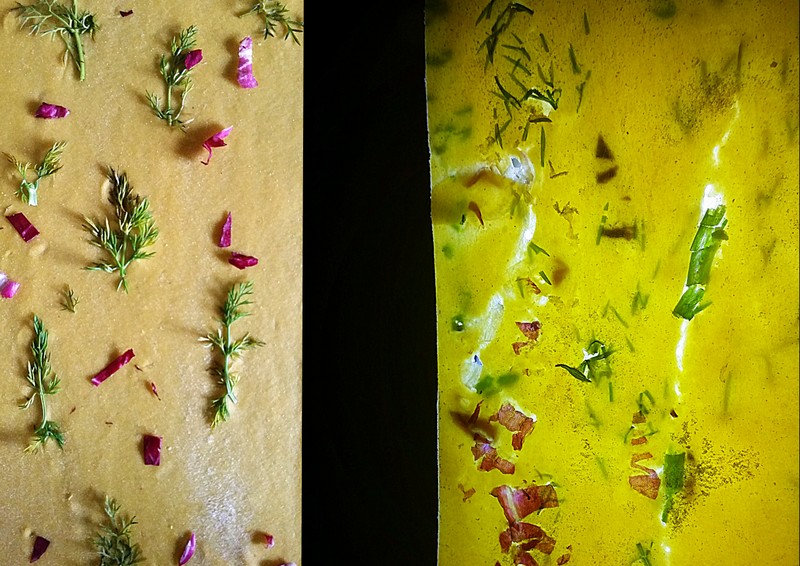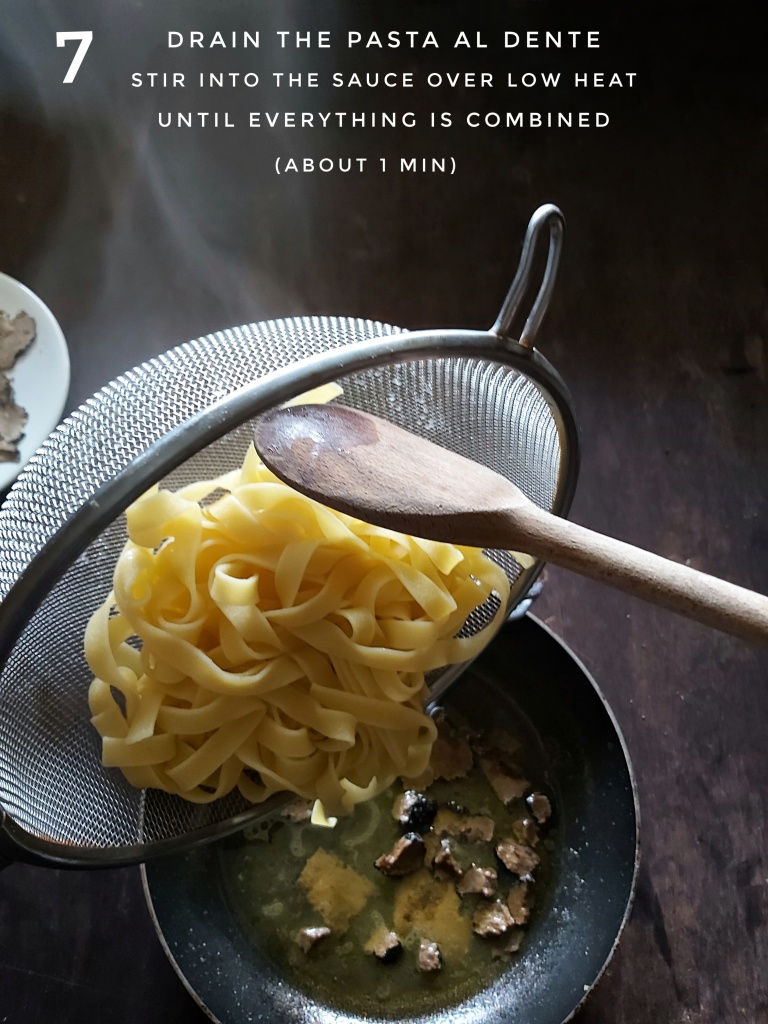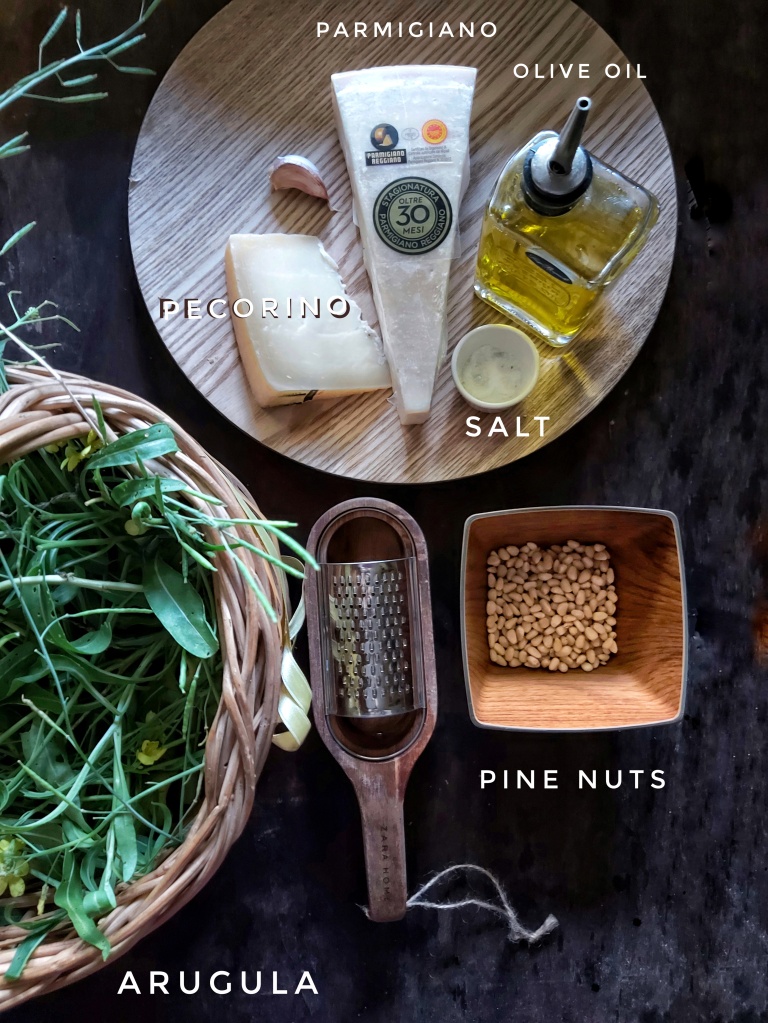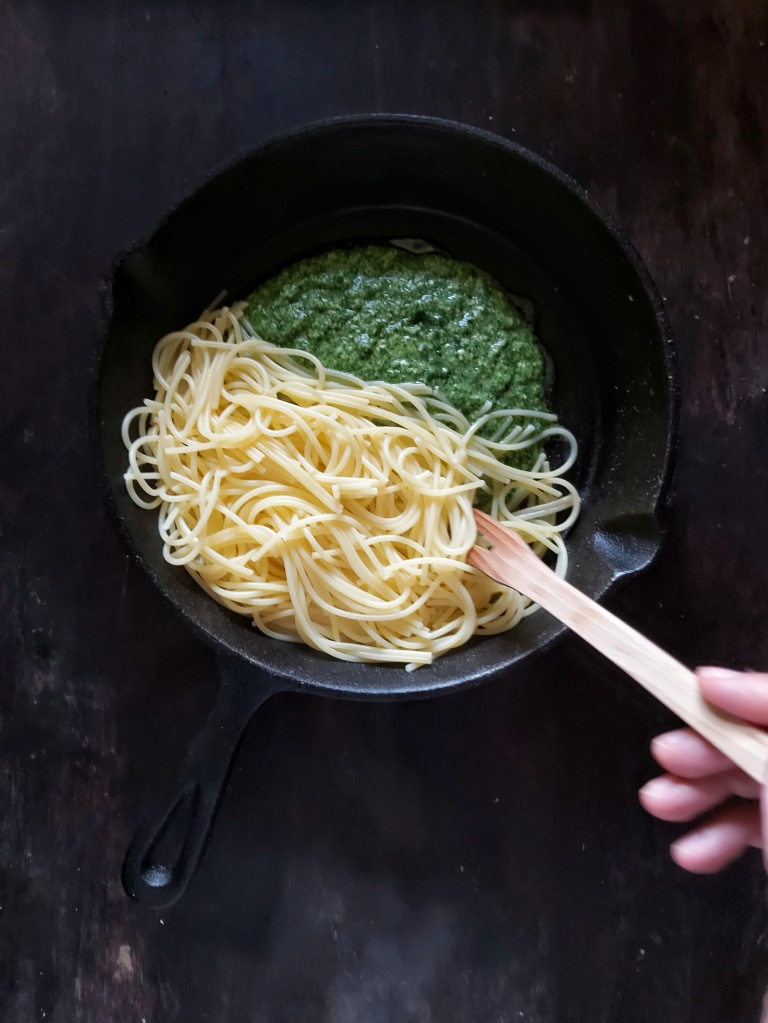

BLACK TRUFFLE FETTUCCINE
One of the simplest recipes to make but full of aroma and exceptional flavor. You just have to cook the pasta and flavor the melted butter with the truffle slices ( for few seconds) so through the butter, all the aroma will be absorbed by the pasta. Off course you can scratch the truffle raw on pasta for a more intense scent. Healthy, nutritious, quick.
Truffles are the fruiting body of an underground Ascomyta mushroom. Low in calories, low fat, low salt and have no cholesterol. They provide an enormous amount of dietary fiber, proteins, potassium, vitamin A, vit D, vit C, vit B6 , calcium, iron, magnesium.
In Latin called “terrae tuber” (excrescence of the earth) or simply tuber, it was highly appreciated by the ancient Romans who had copied the culinary use from the ancient Etruscans. Even the Greeks used truffles in their cooking, as demonstrated by the philosopher Plutarch of Chaeronea in his manuscripts ( 1 century d.C )
In Italy it is always possible to collect truffles, except during the period of the end of april. Traditionally, the harvest was done using a pig. The problem with this method is that the pig is very greedy for truffles and it must be held back to prevent it from eating the product. For these reasons, nowdays are used only duly trained dogs


Ingredients for 2 persons
1 black truffle thinly sliced
200 gr fettuccine
Butter 100 gr
Olive oil 2 tbs
1 clove garlic (optional)
Salt
1.Bring the water to a boil. Season with the salt
2.Cook the fettuccine in the boiling water until al dente.
3. In a medium-sized saucepan, heat the butter & oil until butter it has melted.
4. Add the garlic and the black truffle slides. Cook for about 30 sec.
5. Add half cup of the pasta cooking water into the pan with the butter & truffle. Let boil the sauce. Drain the pasta. Must be very al dente because cooking will continue in the sauce
6. As soon as it starts to boil, add the drained pasta into the butter sauce. Toss over medium heat to coat the pasta.
Serve if you desire with Grana Padano cheese, ground pepper and fresh grated truffle. Serve with the aromatic red Nebbiolo wine from Piemonte region or – if you prefer a rustic flavor – with Pinot Nero from Mugello (Tuscany) .
Buon appetito.
To preserve all its aroma, a truffle should not be cooked too much. Add them just before consuming the meal, at the end of the cooking. In fact, eating fresh, just-harvested truffles raw is a great way to savour the taste of them

See above step by step the procedure
Arugula pesto

Arugula or rocket pesto is a classic cream / sauce of Italian cuisine. it is used to season pasta or on slices of toasted bread (bruschetta).
It is the variant of basil pesto. Its flavor depends a lot on the arugula used, for example wild arugula has a stronger flavor than cultivated. For this recipe has been used half selvatic and half cultivated. Rocket pesto is prepared by combining a few healthy ingredients, which go well with the intense flavor of this herb, such as extra virgin olive oil, garlic, parmesan cheese, pecorino and pine nuts. The latter can be replaced with other valid alternatives, such as walnuts, almonds or pistachios. In any case, it is a condiment that represents a real detoxifying product
Ingredients:
150 gr arugula – 100 gr parmigiano or grana – 50 gr pecorino cheese – 100 gr pine nuts – 200gr extra virgin olive oil – 1 garlic clove
Method: Combine all ingredients in a food processor and pulse until creamy and homogeneous.
Cook spaghetti al dente (i use Barilla gluten free) . Drain them. Heat the pesto in a pan for 1 – 2 minutes. In the same pan add the spaghetti and mix well with the pesto. Serve immediately with a fresh dry white wine such as Fiano d’ Avellino or a Greek Kallisti Reserve’ from Santorini, fermented in oak barrel.
STORAGE The arugula pesto can be kept for 2-3 days in the refrigerator, in a hermetically sealed jar well covered with a layer of oil. Alternatively,it can be frozen in small jars and then defrosted in the refrigerator or at room temperature.

Wild Boar Ragu’ cooked in clay pot with mushrooms, Greek olives & Gragnano pasta / Αγριογουρουνο ραγου με μανιταρια, μαυρες ελιες και ζυμαρικα Νοτιου Ιταλιας (Gragnano village)
Wild Boar is a natural meat very low in bad cholesterol, low in sodium and an excellent source of monounsaturated fats and zinc. No added hormones, no antibiotics, no steroids, no additives.
Very high in proteins. Proteins are made up of amino acids. Our body use them to build and maintain our bones, muscles, cartilage skin and blood. Protein is also what the body uses to repair damaged tissue. The benefit of wild boar meat is it contains ALL the essential amino acids (proteins) our body requires.
Wild boar is rich in Iron, Selenium, Zinc. Rich also in Thiamine (B1), Riboflavin (B2) Niacine (B3) ,Vitamine B6. Our body does not produce these vitamins naturally so they must be obtained from the food we eat. These vitamins are used by our bodies to convert the food we consume into energy. This improves our metabolism. A person’s nervous system and brain function are also dependent on these vitamins beacause they improve our immune systems, help regulate our moods and reduce stress.
![20200106_140743-01-01-01[1]](https://enogastronomista.files.wordpress.com/2020/02/20200106_140743-01-01-011-1.jpeg)
INGREDIENTS:
- 500 g wild boar
- Gragnano pasta or other of your choice
- 1 onion peeled and halved
- 1 carrot washed and cut into large pieces
- 1 celery stalk washed and cut into large pieces
- bay & rosemary leaves
- 2 tsp juniper berries
- 1 lt red wine
- 2 lt tomato passata
- 1 onion peeled and finely chopped
- 1 carrot washed and finely chopped
- 1 celery stalk washed and finely chopped
- 3-4 tbsp extra virgin olive oil
- 3 glasses red wine (room temperature)
- salt
METHOD:
-
Wash the wild boar meat, cut it into pieces. Put it in a large bowl.
-
Add the onion (peeled and cut in quarters) the carrot and the celery in large pieces, the bay leaves, the rosemary, the juniper berries.
-
Cover with red wine and mix.
-
Cover the container with plastic wrap or a lid and allow to stand in the refrigerator for 24 hours.
-
Once the necessary time has passed, drain the meat and eliminate the wine, the vegetables and the herbs.
-
Heat the extra virgin olive oil in a large frying pan or skillet and fry very slightly the garlic, carrot, celery and onion
-
Add the wild boar meat and brown it on all sides.
-
Add the red wine (3 glasses), lower the flame and cook for about 10 minutes so the alcohol can evaporate.
4. Add the tomato pulp, a pinch of salt and cook with the flame reduced to a minimum for about 1.5-2 hours. Stir occasionally and add some water if the sauce seems dry.
After 2 hours, cook the pasta al dente, add the paccheri pasta into the ragu’ and mix carefully. Serve immediately.
![20200106_123801-02[1]](https://enogastronomista.files.wordpress.com/2020/02/20200106_123801-021.jpeg)
GRAGNANO PASTA
The first secret of this amazing pasta is the land where the wheat is cultivated. Situated at the foot of Monte Lattari, Gragnano village (near Naples/Campania) benefits from a microclimate made of the right mix of dry wind from the mountain, sun, and humidity from the sea. It was for this reason that, in the 18th century, the king of Napoli decided that only two places were suitable to cultivate the wheat for the rest of the population: Naples and Gragnano. The pasta also must be made by mixing durum wheat with the calcium-poor water of Monti Lattari.
The second secret is the carefully-developed process, which continues to be regulated by a strict standard of production. In 2013, the European Union declared PGI (Protected Geographical Indication): the pasta made under the name “Pasta di Gragnano” must be produced in a legally defined area that still corresponds to the territory indicated by the king of the Napoli about two centuries ago.
Finally, the dough must be extruded through rough bronze forms and, once it has taken shape, dry at low temperatures in the mountain air. The result of this long and traditional process is one of the finest pastas in the world.
excerpt from the article “WHY PASTA DI GRAGNANO IS SO DELICIOUS” (Eataly)




Oven Octopus Linguine
Probably the easiest way to cook a big octopus. Incredibly easy recipe to make succulent and fork tender tentacles that really melts in your mouth.
Cooked very slowly for 2 hours, the octopus exudes the most delicious juices, so the linguine pasta absorb all this savory. Obviously you can substitute with any type of pasta.

Ingredients:
- 1 kg octopus
- 3 tablespoons extra virgin olive oil
- 2 cups white wine
- 1 handful parsley
- 1 garlic
- pinch of salt
- 300 gr linguine
Method:
Clean the octopus, eliminate the eyes and mouth, wash it several times, and beat lightly on a work-surface to tenderize it.
Cut it in pieces. Put them in a pan roomy enough to easily contain them. Add the oil, the white wine, the garlic, parsley and season with salt. Cover the pan with its lid or with aluminium foil, so that the octopus pieces are hermetically closed. Bake in a moderate oven (350° F – 180° C) for 2 hours.
Place the octopus on a serving plate and keep hot.
Put linguine in the same pan into octopus juices. Cook for about 10min. or until pasta is al dente. Stir occasionally. When it is almost ready add in the pan the octopus pieces and serve with a sprinkle of parsley and ground black pepper (optional).
(This recipe is for 300 gr linguine. If you wish to cook more pasta simply add 1 – 2 cups of boiling water in the pan)

Rigatoni Pasta Pie
Trasform an Italian classic pasta dish into an attractive cheesy pasta pie. Just stuff rigatoni with sauce, layer with mozzarella and bake it for few minutes. Nothing simpler, nothing more delicious & succulent. Bon appétit!

Ingredients:
500 gr rigatoni pasta
500 gr ground beef meat
- 2 tablespoons olive oil
- 2 cloves garlic, minced
- 1/4 teaspoon freshly ground pepper
- 1 bottle (500ml) tomato sauce
- Butter, for pan
- 1 cup finely grated Parmesan cheese
- 250gr grated mozzarella cheese
Method:
-
Preheat oven to 400F (200°C). Bring a large pot of water to a boil; add salt. Add pasta; cook until slightly underdone.Drain, rinse in cold water, and drain. Toss pasta with 1 tbs oil to coat.Set aside.
-
Heat 1 tbs oil in a large skillet over medium-high heat. Add meat. Cook, stirring occasionally, until browned, about 10 minutes. Add garlic, 1 teaspoon salt, and pepper. Cook 2 minutes more.Add tomatoes; simmer until thickened, about 20 minutes.
-
Butter a 9-inch (23cm) springform pan. Toss pasta with Parmesan cheese. Tightly pack pasta into pan, standing each piece on end.
-
Spread meat sauce on top of pasta, pushing it into holes. Bake 15 minutes. Sprinkle mozzarella on top.Bake until cheese is pale golden, 10 to 15 minutes more.Remove from oven, and let stand 15 minutes.Run a knife around edge to loosen; unmold.Cut into wedges & serve with fresh Rosso di Aprilia DOC red wine

(Recipe by Martha Stewart)

Wild boar ragù with pappardelle/Ραγου αγριογουρουνο με παπαρδελες
A traditional recipe of Tuscany (a region in central Italy) is wild boar ragù with pappardelle (Ragù di cinghiale con pappardelle).
Boars are highly widespread throughout the region, especially in the Maremma, where it has became a local symbol. In Tuscany, wild boar hunting is both a tradition and a passion.
With pasta or in a stew, there are countless Tuscan specialties made with wild boar and you can taste them all at many food festivals (sagre del cinghiale), maybe accompanied by some other local delicacies, such as “tortelli” or “pappardelle” . Here a 4 steps recipe from “Jamie’s Italy” cook book by Jamie Oliver. Enjoy with a fresh red “Chianti lo Sterpo”





Sugo di Cinghiale di Mercatello (Jamie Oliver recipe)
2 1/4 lb wild boar cubed, trimmed of fat and sinew
2 large carrots, peeled
2 onions, peeled
6 stalks of celery
a handful of sage leaves
1 tsp juniper berries
1 bottle red wine
4 pieces of pancetta, black olives
2 – 3 small dried chilies, to taste
1 1 1/2 lb tomato puree
olive oil
sea salt
freshly ground pepper
1.Put the meat into a large sealable bag. Roughly chop half of the carrots, onions, and celery. Add to the meat in the bag. Bash up the sage with the juniper berries and toss with the meat and vegetables.Season with salt and pepper. Pour in half of the bottle of wine, topping up with water if necessary. Seal and place in a large bowl in the refrigerator overnight.
2.Remove the meat from the marinade, discarding the liquid and vegetables. Decide how you wish to serve your sauce and cut the meat accordingly
3.Heat a splash of olive oil in a large pot over medium high heat. Fry the pancetta and chili until the pancetta is golden and crisp. Chop the remaining carrot, celery, and onion, add to the pan, and cook slowly for 10 to 15 minutes. Turn the heat to high and add the meat to the pan. Cook until nearly all of the liquid has cooked off – this takes some time but will intensify the flavours.
4.Pour in the remaining wine. Stir together and continue cooking until; the liquid has nearly gone, then add the tomato sauce, black olives and a little water (if necessary). Season well with salt and pepper, turn the heat to low, simmer gently for 1 1/2 – 2 hours, adding more water if the sauce gets too thick.
Cook pappardelle in boiling salted water, drain it, reserving some of the cooking liquid. Toss the pasta with the sauce, adding a little of the reserved cooking liquid. Divide it amongst the plates and sprinkle with Parmesan. Enjoy with a fresh “Chianti lo Sterpo” red wine from Tuscany.

A.Put the meat into a large sealable bag. ( I use a large Pyrex glass bowl). Roughly chop half of the carrots, onions, and celery. Add to the meat in the bag. Bash up the sage with the juniper berries and toss with the meat and vegetables.Season with salt and pepper. Pour in half of the bottle of wine, topping up with water if necessary. Seal and place in a large bowl in the refrigerator overnight.

B.Heat a splash of olive oil in a large pot over medium high heat. Fry the pancetta and chili until the pancetta is golden and crisp. Chop the remaining carrot, celery, and onion, add to the pan, and cook slowly for 10 to 15 minutes.

C.Turn the heat to high and add the meat to the pan. Cook until nearly all of the liquid has cooked off – this takes some time but will intensify the flavours.

D. Pour in the remaining wine. Stir together and continue cooking until; the liquid has nearly gone, then add the tomato sauce, black olives and a little water (if necessary). Season well with salt and pepper, turn the heat to low, simmer gently for 1 1/2 – 2 hours, adding more water if the sauce gets too thick.



Great food in a typical Florence taverna


Herb laminated fresh pasta / Λαμιναρισμενα διφυλλα ζυμαρικα με βοτανα/ Pasta fresca laminata con erbe













Aromatic fennel + purple cabbage




 Ingredients: 340 gr flour for pasta ( 70 % semolina flour + 30% all purpose flour)
Ingredients: 340 gr flour for pasta ( 70 % semolina flour + 30% all purpose flour)
4 eggs , fresh herbs ( sage , thyme , aromatic fennel , chives, marjoram,
basil , parsley , dill , tarracon , rosemary , mint etc )
Method: Step by step home made fresh pasta instructions (with photos)
- Mix together flour with eggs until ball is formed.
- Knead dough until is smooth (about 10 min)
- Cover with plastic wrap and let sit at room temperature for about 15 min
- Divide your dough into 6 equal parts
- Use the pasta machine to roll each piece of the dough until it is thin as possible (adjusting machine to thinner settings after every pass and dusting with flour if sticky , until pasta sheet is thick – setting 9 on most machines).
- Place the first 3 pasta sheets in a single layer on a lightly floured surface .
- Now spread your herbs on pasta .Use the remaining 3 sheets to cover the others (pic3)Gently press together to hold the leaves in place.
- Pass these doubled sheets through the roller (pic 4) starting with setting # 6 , until sheets and herbs are well pressed together
- Cut your laminated pasta as you want (Cannelloni , lasagna, tagliatelle , pappardelle etc).
- Bring a large saucepan with water to a boil. Add the salt and the pasta. Cook until al dente ( 5 minutes )
Serve with fresh oil or butter





















![20200106_133833-02[1] 20200106_133833-02[1]](https://enogastronomista.files.wordpress.com/2020/02/20200106_133833-021.jpeg?w=471&resize=471%2C628#038;h=628)
![20200106_121901-02[1] 20200106_121901-02[1]](https://enogastronomista.files.wordpress.com/2020/02/20200106_121901-021.jpeg?w=471&resize=471%2C628#038;h=628)























